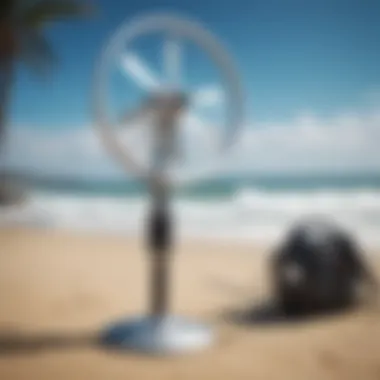Techniques for Assessing Wind Speed in Surfing


Intro
Understanding wind speed is like having the cheat codes for surfing. It's not just about riding the waves; it's also about riding the right waves at the right time. For every surfer, from the greenhorn riding their first board to the seasoned shredder conquering monster swells, knowledge of wind conditions can make or break an outing.
Wind influences wave formation, height, and the overall surf experience. Brisk winds create formidable waves, while gentle breezes might leave a surfer stuck in flat waters. If you can't gauge wind speed accurately, you might end up bitten by the unpredictable nature of the ocean.
In this guide, we'll cover various techniques for assessing wind speed, from the time-honored tricks used by old-school surfers to the high-tech applications available today. This will help you not just to know the wind speed but also to improve your on-water decisions, enhancing the thrill and safety of your surf adventures.
We'll dive into equipment reviews, share tips suitable for beginners as well as seasoned surfers, and provide insights on how these parameters can turn an average day at the beach into an epic session. With the right knowledge under your belt, you’ll be able to approach every surf trip like a seasoned pro.
So, grab your board and let’s get rolling!
Foreword to Wind Speed Measurement
Understanding how to accurately measure wind speed is not just a minor detail in the surfing community; it is fundamental to ensuring a safe and thrilling experience on the waves. So much hinges on the wind's influence, from wave formation to paddle out conditions. For surf enthusiasts, having a solid grasp of the nuances of wind speed measurement can significantly enhance their time spent on the water.
Significance of Wind in Surfing
The wind plays a vital role in determining surf conditions. It drives the formation and direction of waves, influencing their height, shape, and break. For surfers looking to catch the perfect wave, knowing the wind speed can make a world of difference. A gentle breeze might create ideal conditions, while strong winds can lead to choppy, inconsistent waves that are less enjoyable to ride. Understanding this relationship isn’t simply theoretical; it directly correlates to better performance and safety.
Moreover, winds affect the tide, which can change dramatically within hours. A knowledgeable surfer will monitor wind patterns closely to capitalize on rising swells that coincide with optimal wind directions. Knowing how to gauge wind speed gives surfers an upper hand, allowing them to read the conditions like a pro.
Challenges of Measuring Wind Speed
Measuring wind speed is not as straightforward as it might seem. One major challenge is that the wind does not blow uniformly. Factors such as terrain, nearby structures, and even local weather patterns can cause fluctuations that make it tricky to gauge the speed accurately. On one day, you might find that the wind speed just a few hundred feet away can differ substantially from what you observe where you stand.
Additionally, traditional measuring devices, like anemometers, require careful placement and calibration to obtain reliable readings. Environmental conditions—trees swaying on the coastline or buildings redirecting wind—may skew these numbers as well. Moreover, surfers often rely on weather forecasts, which provide average winds but can miss specific gusts that have a significant impact at the beach.
"An accurate understanding of wind conditions can effectively separate a novice surfer from a seasoned pro."
To navigate these challenges, surfers can resort to various techniques—both traditional and modern—that will aid in understanding the whims of the wind. This adaptability not only increases their chances of having a great surf session but also enhances safety on tumultuous days.
Traditional Methods of Measuring Wind Speed
Understanding traditional methods of measuring wind speed is crucial for surfers who want to optimize their time in the water. Accurate wind measurements can make the difference between a thrilling session and barely catching a wave. These methods have been utilized for years and provide reliable insights into wind conditions. The significance lies in the fact that traditional tools have withstood the test of time, showcasing resilience, precision, and, in many cases, simplicity. This section dives into anemometers and wind vanes, exploring how these instruments can significantly enhance a surfer's experience.
Using an Anemometer
Types of Anemometers
An anemometer is a pivotal instrument for gauging wind speed and it comes in several varieties, each designed with unique features to suit different needs. The three main types include cup, vane, and digital anemometers.
- Cup Anemometers: The most commonly recognized type. They consist of three or four cups mounted on arms that rotate around a central axis. As the wind blows, the cups spin, allowing the device to measure wind speed accurately.
- Vane Anemometers: These have a rotating blade, similar to a small propeller. Their design allows them to measure both wind speed and direction, making them quite useful for surfers looking to understand wind patterns.
- Digital Anemometers: These modern gadgets often come with digital displays and additional features like data logging, ideal for tech-savvy surfers.
- Advantages: Durable and straightforward to use.
- Disadvantages: They can lag in responsiveness during sudden gusts.
- Advantages: Multi-functional; provides direction alongside speed.
- Disadvantages: Slightly more complex, possibly requiring calibration.
- Advantages: User-friendly and often highly accurate.
- Disadvantages: Can be pricey and may need batteries or charging.
Choosing the right type of anemometer can significantly impact a surfer’s ability to read and react to wind conditions effectively.
How to Use an Anemometer
Using an anemometer is relatively straightforward, yet it requires some attention to detail. For anyone looking to get precise wind speed measurements, here are essential steps:


- Placement: First and foremost, place the anemometer away from obstacles like trees or buildings. This ensures an undisturbed airflow that provides a more accurate reading.
- Initial Checks: Before taking measurements, ensure the anemometer is functioning correctly. Check for any obstructions that might hinder its movement.
- Monitoring: Hold the device at shoulder height to achieve optimal readings. Most anemometers have a display that updates the wind speed in real-time, making it easier for surfers to adapt to changing conditions.
- Recording Data: If your anemometer allows, save the readings. Tracking wind patterns over time can help surfers understand their local surf spots better.
Anemometers offer a reliable way to assess wind speed sytematically, and with practice, surfers can become adept at reading conditions more instinctively. Their ability to provide real-time data puts them at the forefront of wind measurement tools.
Wind Vanes and Their Applications
Wind vanes, while often overshadowed by anemometers, play an equally important role in understanding winds. These devices indicate wind direction, giving surfers crucial information about which way the waves might break. A wind vane’s position tells you precisely where the wind is coming from and can drastically affect what to expect upon hitting the waves.
- Understanding Direction: Knowing the wind direction can help surfers gauge potential wave quality. For example, an offshore wind generally means cleaner waves, allowing surfers to maximize their performance.
- Integration with Other Tools: Wind vanes are sometimes used in conjunction with anemometers. This combination can provide a comprehensive overview of both speed and direction. It allows for a more thorough understanding of conditions.
- Field Applications: In practice, surfers often observe the movement of flags or trees as a way to estimate both speed and direction of the wind, acting like a DIY wind vane.
In short, while often overlooked, wind vanes offer vital details that can be the cherry on top when choosing the right surfing conditions.
"Wind measurement techniques, whether traditional or modern, are foundational for making savvy decisions in the surf, turning good days into great ones."
Understanding these traditional methods arms surfers with the knowledge they need to pick the right moments to catch those epic waves. Consistency and accuracy in measurements can significantly impact surfing experience, paving the way to improved skills on water.
Estimating Wind Speed by Observation
When it comes to catching the perfect wave, understanding how to estimate wind speed by observation can give surfers an edge. This approach is not just about using sophisticated gadgets or apps; it taps into something a bit more intuitive and immediate. Surfers, whether novices or seasoned pros, can benefit from recognizing the natural signs that the environment presents. This knowledge offers them a chance to make informed decisions before heading out to the water.
Assessing Wind Effects on Surfers
Wave Height Analysis
Wave height analysis plays a fundamental role in estimating wind speed because it reflects the interaction between wind and water. Surfers often look for specific wave heights that are conducive to riding—something in the range of waist-high to over-head can be ideal. Understanding how wind affects wave height enables surfers to predict the conditions they’ll face.
A crucial characteristic of wave height analysis is that it provides immediate, visible feedback. If winds are blowing steadily over a longer period, this generally leads to larger, more powerful waves. That said, it's important to consider local conditions such as wind direction and structure of the seabed, which can distort this relationship.
The unique feature of wave height analysis is its dependence on real-time observation. While seasoned surfers might recognize the subtleties, others may miss out on how varying winds impact wave formation. The advantage here is clear: real-time analysis allows surfers to make quick decisions based on what they see, but it can be misleading if they don’t factor in additional elements like swell direction or geographical variations.
Surface Water Movement
Surface water movement provides another layer of understanding when estimating wind speed by observation. Watching how water flows can give surfers hints about wind patterns—a more turbulent surface often indicates stronger winds. The main characteristic here is the visible ripples and minor currents created by local wind conditions, which tell a seasoned eye that wind is at play.
One benefit of observing surface water movement is that it is accessible to everyone; no fancy equipment is needed to notice how the water acts. Surfers can easily gauge whether conditions are right for them simply by taking a moment to watch the water move. However, this method does have its downsides—the surface movement can vary significantly depending on factors like tides and geographical location, sometimes making it a bit tricky to interpret.
In summary, while these observational techniques may not have the precision of technological gadgets, their practicality and immediacy make them invaluable in the ever-changing ocean environment. Paying attention to wave height and surface water can dramatically improve a surfer’s ability to pick the right time for heading out.
Observing Vegetation and Surroundings
The environment around us often acts as a witness to wind speed. Observing the foliage and other natural elements can reveal a great deal about the wind conditions—from the way grass sways to the movement of trees. For surfers, this information can help determine whether to grab the board or stay on land.
The beauty of this method lies in its simplicity. Watching the trees sway, for example, can provide insights into wind speed. If branches are moving wildly, it might be too windy for a safe surf session. Conversely, gentle rustling might indicate optimal conditions.
Incorporating environmental observation enhances the understanding of wind speed in a more organic way. It connects surfers to nature, allowing for a deeper appreciation of their surroundings while improving their decision-making process.
"Understanding the world around us is as crucial as mastering the waves—nature has a language, and it’s our duty to listen."
By employing these observational techniques, surfers can refine their skills and strategies, tuning into both their immediate environment and their sport.
Technological Advances in Measuring Wind Speed
The advent of modern technology has truly changed the game for surf enthusiasts keen on assessing wind speed accurately. In the surf community, knowing about wind speed can mean the difference between catching that perfect wave or sitting on the shore, twiddling thumbs. This section sheds light on how advancements in technology are not only making wind speed measurement more accessible but also more precise, allowing surfers to make informed decisions before hitting the waves.
Smartphone Applications


With smartphones becoming ubiquitous, it's no surprise that surfers are turning to apps tailored for wind speed detection. These applications have revolutionized the way surfers gather real-time data about conditions at their favorite surf spots.
Top Wind Speed Apps
When it comes to top wind speed apps, a few gems stand out. From reliable sources like Windy and Surfline, these apps offer surfers a blend of accurate forecasts and real-time updates. A standout characteristic of these applications is their user-friendly interface, making it easy for both novice and experienced surfers to navigate. What sets them apart is their ability to provide hyper-localized data, tapping into weather stations that can be as near as a few miles away from the beaches.
Regardless of weather conditions, these apps calculate not only wind speed but gusts, which adds to their composition. However, it’s worth noting that while these apps have many advantages, they may rely on data from nearby weather stations that might not perfectly reflect conditions at specific surf sites.
How Accurate are Mobile Apps?
The accuracy of mobile apps can be somewhat of a mixed bag. Many surfers have found that while apps like Windy provide a general idea of conditions, the accuracy can fluctuate based on several factors—location being a major one. The significant characteristic that keeps these tools relevant is their ability to aggregate information from multiple data sources, which usually enhances reliability.
Each app boasts unique features: some focus on graphical forecasts while others may include real-time webcams for surfers to visualise conditions before heading out. However, users should remain cautious since factors like local geography and unexpected weather patterns can skew the predictions, rendering real-time checks a must.
Online Wind Speed Monitors
Apart from smartphone applications, online wind speed monitors serve as another effective tool for eager surfers. Websites providing live data from various surf spots can give surfers straightforward information about current wind conditions. By tapping into regional meteorological data, these resources help users plot a course to favorable surf conditions.
Utilising online wind speed monitors can be liberating for surfers. It provides the convenience of checking conditions while sipping morning coffee or during a lunch break, saving time and enhancing preparation without leaving home. It's easy to see the appeal: just a quick look online and you can assess if it’s worth your time to rush to the water or if it’s better to bide your time a bit longer.
Understanding Wind Speed Units
Understanding wind speed units is paramount for surfers and wind enthusiasts alike. These units serve as a common language, facilitating clearer communication regarding surfing conditions. Grasping these measurements equips surfers with the ability to interpret various reports and make informed decisions about when and where to hit the waves. This section delves into the common measurement units that gauge wind speed, breaking down their characteristics, benefits, and the nuances that each brings to the table.
Common Measurement Units
Miles per Hour
Miles per hour (mph) is one of the most familiar and widely used units to report wind speed. In many parts of the world, particularly in the United States, this unit serves not only to measure wind but also works as a benchmark for commuters. One key characteristic of mph is its simplicity; it relates directly to how fast one might drive a car or bike. For surfers, mph can provide a quick intuition of the wind's impact on waves and current conditions.
Its unique feature lies in the relatability; surfers can often visualize how wind speed affects conditions when they think about the speed of an automobile. However, one drawback is that it can become less meaningful on the water compared to nautical units, primarily used in maritime contexts.
Knots
Knots is another prevalent measurement in the realm of wind speed, particularly within marine environments. The unique aspect of knots comes from its definition, being one nautical mile per hour. This characteristic helps sailors and surfers interpret wind conditions that may affect performance and safety. Knots are crucial for understanding the behavior of waves and currents, making it a favored choice for those within the surfing community.
The advantages of using knots include its direct relevance to navigation and sailing. It aligns seamlessly with nautical charts and maps. On the flip side, it might pose a challenge for those more accustomed to using miles per hour, leading to potential confusion when converting between the two. Still, for surfers accustomed to the ocean's language, knots is the preferred unit.
Beaufort Scale
The Beaufort Scale offers a qualitative approach to assessing wind speed and its effects. Rather than providing a numeric measurement, this scale describes wind strength through observable conditions, ranging from calm water to gale-force winds. One significant advantage of the Beaufort Scale is its ability to relate various wind speeds to the effects felt on the water and land.
Its unique feature is how it translates wind conditions into practical observations—instead of just stating how fast the wind blows, it describes what surfers should expect. This method helps clients assess risks more intuitively. Nevertheless, a potential limitation is the degree of subjectivity; different individuals may perceive the same wind conditions quite differently.
Interpreting Wind Speed Reports
Interpreting wind speed reports is crucial for making decisions about surfing conditions. Wind reports can vary depending on the source but typically include information in various units like mph or knots. Understanding these units allows surfers to gauge conditions without confusion. It’s essential to cross-reference different sources, like local surf forecasts or weather websites, to get a more complete picture. Additionally, knowing how local factors—like geography or time of day—can influence wind readings is important.
"Even a small gust change can make a world of difference on the water. Understanding wind speed units is the first step toward surf success!"
By familiarizing oneself with the nuances of each measurement unit, a surfer can significantly improve their ability to interpret critical information for better performance and safety on the waves.
Practical Applications of Wind Speed Knowledge for Surfers
Understanding wind speed can mean the difference between a perfect day on the waves and a washout. For surfer's, being savvy about wind conditions is not just an added bonus; it's essential in maximizing one’s surfing experience. This section delves into how comprehending wind speed impacts your choices in the water, whether you’re a seasoned pro or just starting out.


Choosing Optimal Surfing Conditions
When it comes to surfing, conditions are king. The right wind speed can enhance or ruin the waves, so knowing how to assess this can give you a serious edge. Typically, light onshore winds create nicely shaped waves, while strong winds can flatten or distort them.
Some practical tips for surfers include:
- Monitor Daily Weather Reports: Use reliable apps or websites that include hourly wind forecasts and trends. Knowing the wind’s trajectory and speed gives you a heads-up on when to hit the water.
- Check Local Surf Reports: Many local surf shops or communities share insights on the day's surfing conditions. This can be a goldmine of information to plan your sessions effectively.
- Experiment with Timing: Higher wind speeds in the afternoons may signal choppier waters, while calmer conditions in the mornings might yield better surf. Keep a record of your sessions to help spot patterns specific to your local break.
In summary, being well-informed about wind conditions enables surfers to make informed decisions about when and where to surf. This kind of knowing transforms the usual guesswork into strategic planning.
Safety Precautions in High Winds
Though wind can enhance wave conditions, it can also pose serious risks. Surfers must be vigilant when wind speeds increase, as waves can become unpredictable and dangerous. Here are elements to consider for safety:
- Avoid Overestimating Your Skills: Strong winds can create large, fast waves that may be beyond even skilled surfers' abilities. Knowing your limits is key.
- Monitor for Changes: Always keep an eye on how wind conditions evolve. What started as a perfect day can shift rapidly, catching surfers underprepared.
- Stay Clear of Hazards: High winds can push surfers toward rocks, jetties, or shallow areas, increasing the risk of injury. Always be mindful of your surroundings and the changing conditions.
As important as it is to enjoy the thrill of surfing, your safety should never be compromised. Awareness of wind speed helps ensure that you can ride the waves while staying out of harm's way.
"In surfing, it’s not just about catching the perfect wave. Understanding your environment is key – that includes being clued into the wind."
Future Trends in Wind Speed Measurement
In the fast-evolving world of surfing, understanding the nuances of wind speed measurement has never been more crucial. The push towards enhanced accuracy and convenience reshapes how surfers prepare for their time on the water. As the sport continues to grow and evolve, so does the technology we rely upon to measure wind conditions. Keeping an eye on future trends not only opens the door to new possibilities but also improves decision-making for surf enthusiasts.
Emerging Technologies
Drone Technology
Drones have become a fascinating addition to the toolkit of any serious surfer. They can cover expansive areas and provide a bird's-eye view of the waves and wind conditions. This capability allows surfers to assess surf spots in real-time, making them a popular choice among those keen on optimizing their surf experience.
One key characteristic of drone technology is its ability to capture high-resolution images and videos. This information is immensely valuable as it makes it easier for surfers to evaluate conditions that might not be visible from the shore.
However, as beneficial as drones can be, there are some disadvantages worth noting. For one, not all areas permit drone usage, and local regulations can vary widely, adding an extra layer of complexity. Moreover, the cost of quality drone tech can be a barrier for some. Yet, for those who invest in this technology, the insights gained are often worth every penny spent.
Artificial Intelligence Applications
Artificial intelligence is another realm that's making waves in measuring wind speed and conditions. By utilizing AI algorithms, developers are creating apps that analyze real-time data from numerous sources, giving surfers a comprehensive view of what's brewing in the ocean. These applications can take a multitude of factors into account, such as historical wind patterns and current meteorological data, thus offering predictive capabilities.
A crucial advantage of AI applications is their ability to learn and improve over time. As more data gets fed into these systems, their accuracy and reliability tend to increase, making them a popular choice among tech-savvy surfers.
Nevertheless, AI technology is not without its limitations. Dependency on technology can sometimes be risky, as weather patterns can change swiftly and unexpectedly. Surfers must remain mindful that while these applications provide valuable insights, they should not serve as the sole basis for decision-making.
Integration into Surf Forecasts
The integration of emerging technologies like drones and artificial intelligence into surf forecasts represents a significant leap forward for surfers. By utilizing real-time data gathered from these advanced tools, surf forecasts are becoming increasingly precise, allowing surfers to plan their outings more effectively. This is vital as it can mean the difference between a day spent catching perfect waves and one spent battling bad conditions.
For surfers, the ability to tap into reliable forecasts leads to smarter choices and ultimately better experiences on the water. It’s clear that the future of wind speed measurement holds great promise, so keeping abreast of these trends is worthwhile for anyone looking to enhance their surfing journey.
End
Understanding how to assess wind speed is crucial for anyone eager to get the most out of their surfing experience. The wind is not just a mere background element; it’s a driving force that dictates wave formation, water surface conditions, and ultimately, surfing performance itself. By mastering various techniques of wind speed measurement, surfers can make informed decisions about when to hit the waves, optimizing both safety and enjoyment.
Summary of Key Takeaways
- Importance of Wind Speed: Having a solid grasp of wind speed helps surfers select the right surfing sessions, enhancing performance and reducing risks.
- Techniques Explained: From using anemometers to smartphone apps and online resources, you'll find multiple ways to gauge wind speed.
- Continuous Monitoring: Keeping an eye on wind conditions can elevate your surfing game, allowing for better preparation and more thrilling rides.
- Safety Considerations: Understanding wind speed isn’t just about performance; it’s also about safety and avoiding perilous conditions.
Encouragement for Continuous Learning
As the surfing community evolves, staying informed and adapting to new technologies will set you apart. Whether you’re a beginner or a seasoned pro, consider diving deeper into the science of wind and its effects on surfing. Take advantage of online courses, community forums like Reddit or articles on established platforms like Britannica, to expand your knowledge.
While surfing is an exhilarating sport, the ocean also commands respect. So, take the time to learn about wind speeds, patterns, and the tools available to you. Each session on the water becomes more enriching when armed with knowledge. Moreover, sharing findings with friends can lead to communal growth in understanding and enjoying the sport even more. Stay curious and ride those waves wisely!















